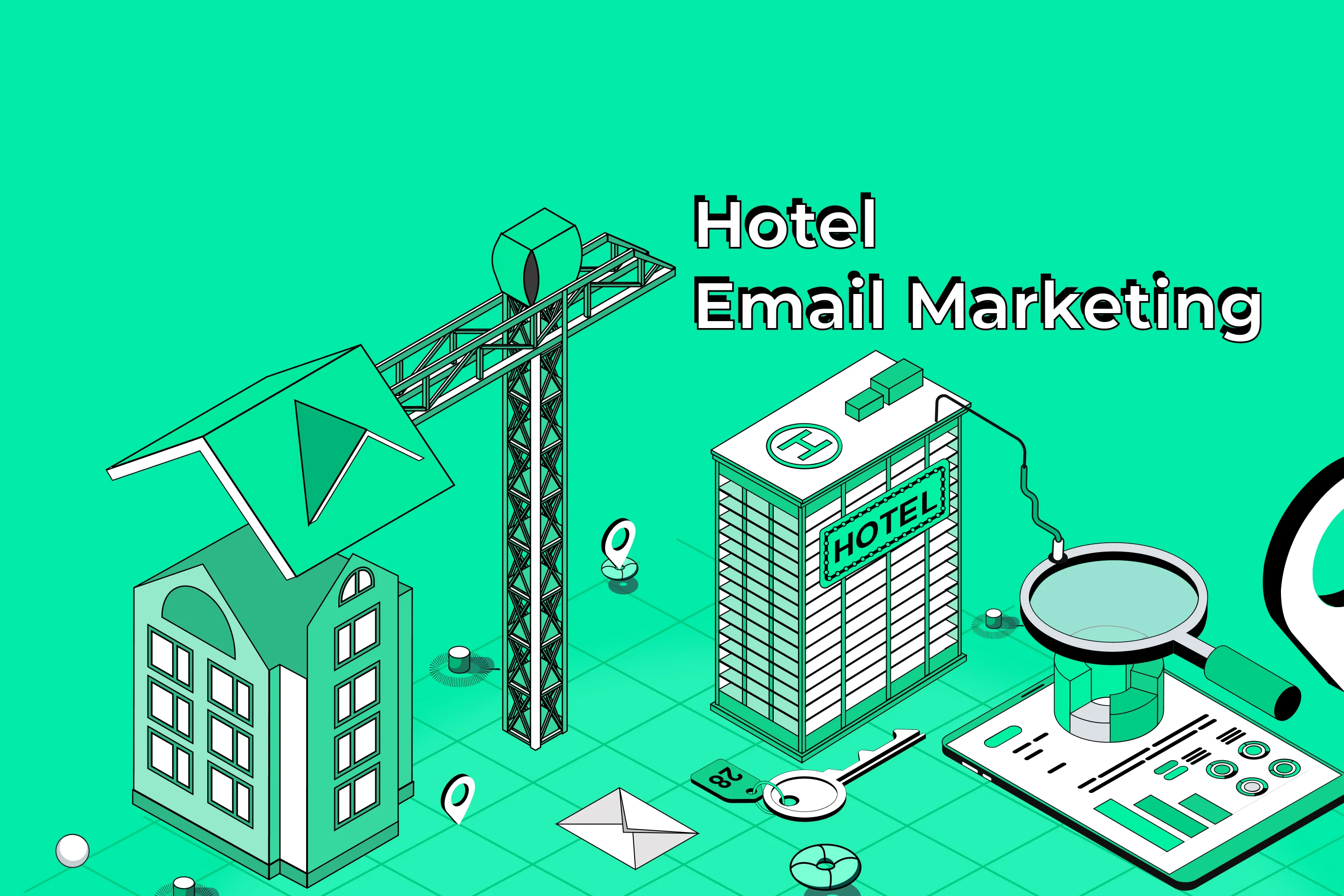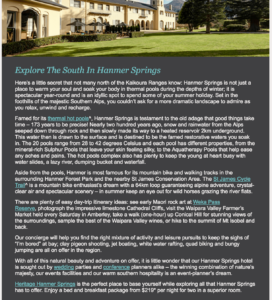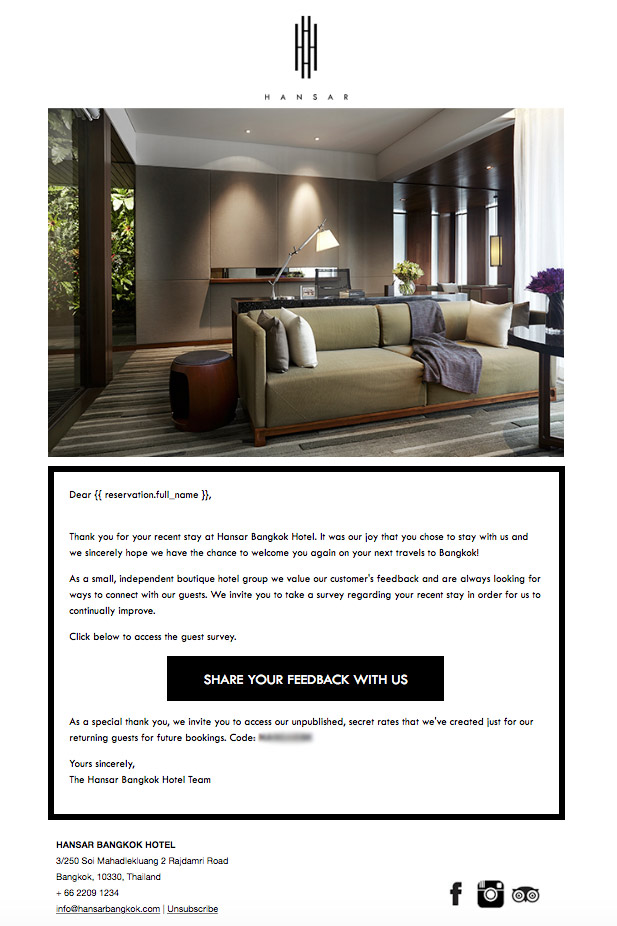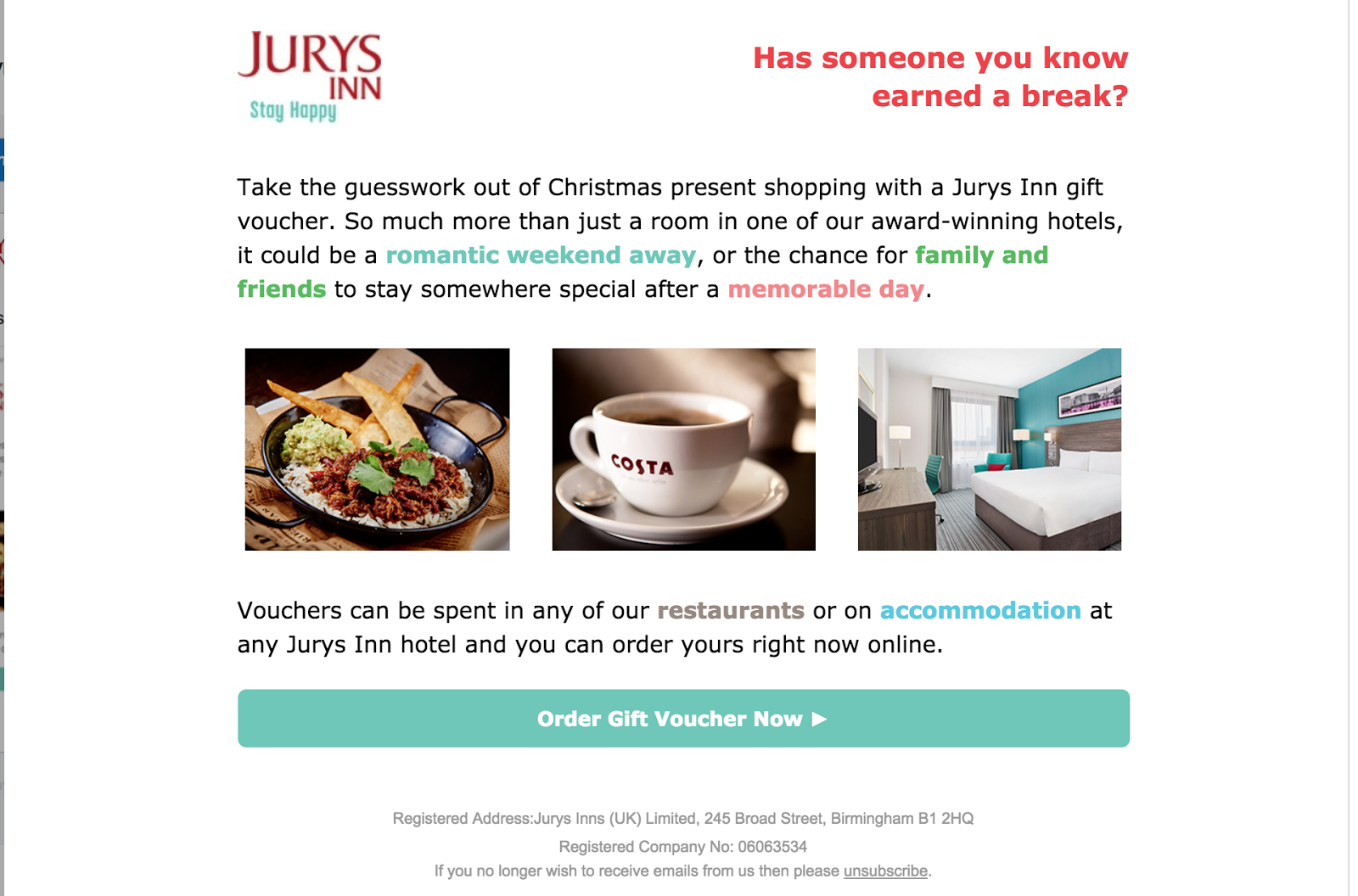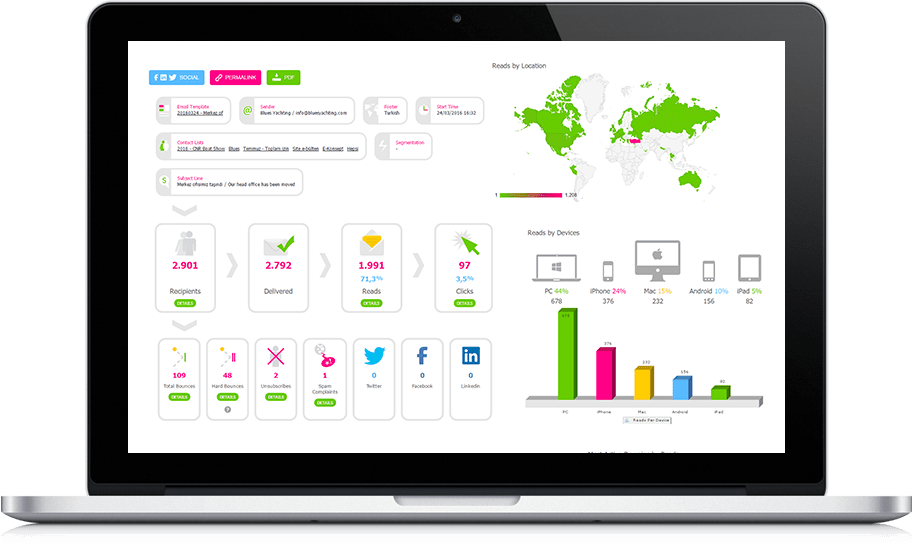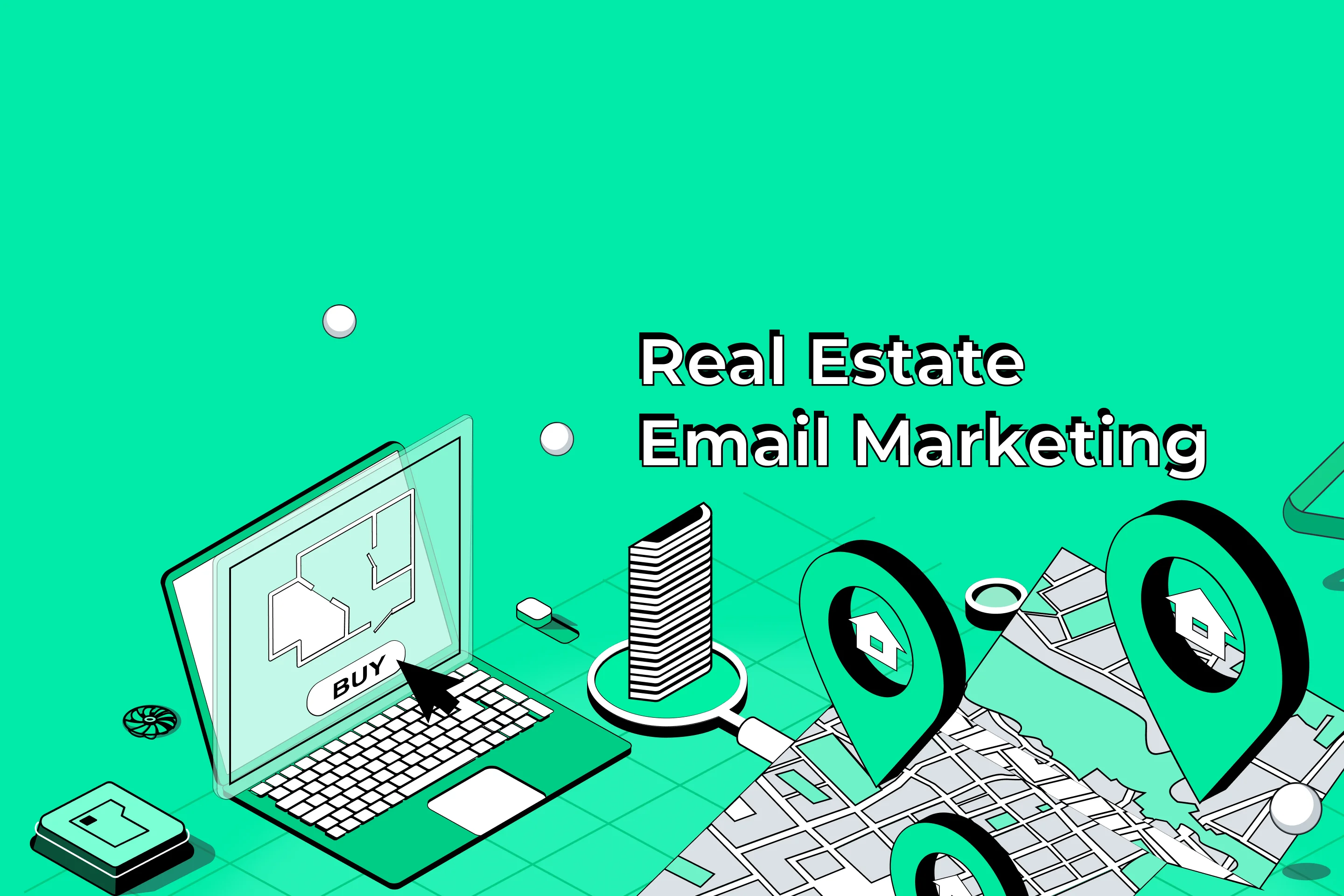Hotel Email Marketing: Complete Guide with Examples [2024]
The hotel industry is becoming more and more competitive, and that’s a fact. The traditional hotel marketing strategy relies on social media and pay-per-click ads (PPC), but the professed “death of email” never came. Plus, paid search is getting more and more expensive in the hospitality industry.
Email marketing is still the primary mode of digital communication between businesses, their customers, and their clients. Email marketing campaigns are up to 40 times more effective at generating a sale than direct mail, Facebook and Twitter and Marketers who are after affiliate email campaigns know this.
This means if you are putting all your energy into other channels and neglecting your email marketing opportunities, you could be missing out on a serious revenue boost. Before talking about email marketing for hotels, let’s take a minute to see why email is such a powerful tool.
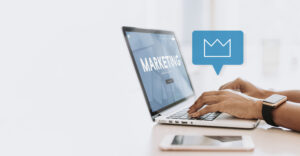
How did email marketing become so powerful?
The email platform itself has been under iterative revision since its beginnings in 1971. So too have Email Service Providers (ESPs) continued to roll out new tools with diverse applications, for both consumers and businesses.
As a marketer, you need to keep track of these developments and the relevant techniques they enable. Mass emailing content and promotions to every person on your mailing list with the hope that some might grow into leads does not really work that well anymore.
Instead, there are tools to maximize the value of your email marketing efforts, that give you the ability to create highly customized email campaigns. If you are currently using an ESP with no opportunity for an advanced email marketing strategy, you’re seriously missing out.
Why does email marketing work so well?
Email marketing has been proven to generate high conversion rates: this means more bookings, higher occupancy rates, increased revenue, and perhaps that long-awaited promotion. Let’s look at why email marketing for hotels helps increase guest loyalty, conversion rate and number of bookings by new customers.
Email marketing is not just an asset to the hotel industry because it shows demonstrative results. By analyzing your guests’ demographics and buying habits you can get a much better understanding of your target audience, increase guest satisfaction and boost conversion rates throughout your other marketing channels.
In addition to that, email marketing campaigns can be created quickly and adjusted on the fly. Other popular hotel marketing strategies like hotel SEO take a long time to develop and can not be changed rapidly.
In this article, we will examine 7 hotel email marketing strategies that are crucial for a campaign’s success, as well as how to refine your hotel email marketing strategy.

7 main takeaways for successful hotel email marketing campaigns
1. Set up sign up emails and confirmation emails
We can’t talk about hotel email marketing without first mentioning these two powerful tools: signup emails and confirmation emails. Confirmation emails, which are sent after a reservation has been booked to confirm the details, have an incredible open rate and therefore, their value should be maximized.
Signup emails, which visitors of your website will receive when signing up for your hotel newsletter, should be also considered a lot when optimizing your hotel’s email marketing campaigns. You should make the signup procedure as simple and quick for your hotel’s website visitors as possible.
Importance of signup emails
Sending a welcome email to visitors who have subscribed to your email list not only confirms their subscription, but it also creates expectations for subsequent communications. Your first email to your potential guests can very well be the deciding factor in whether they ever open a second one. So when you get a signup for your newsletter, make sure not just to thank them for signing up, but warm up their attention by giving hints and ideas about what kind of content the newsletter will include in the future.
What are some steps you can take to improve the signup rate for your hotel’s newsletter?
Make sure signup forms on the website are displayed prominently and are easy to find, and describe the advantages of subscribing succinctly yet in a way that draws people in.
Since many people now use a mobile device to access the web, it’s also crucial to make sure your signup forms are mobile-friendly. On average, 58% of website traffic comes from mobile devices.
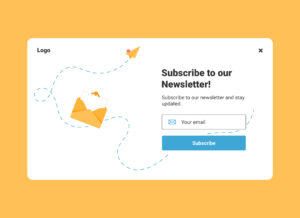
In general, proper setup of signup and confirmation emails is a very important initial step in hotel email marketing. By making the signup procedure simple, you’ll be able to start creating a solid email list and forge meaningful connections with the subscribers, while confirmation emails’ incredible open rate (65% on average) means that whatever content you put inside the email will be highly visible. Use this to your advantage.
2. Segmentation is key for high-conversion email campaigns.
If you are sending emails to every address on your mailing list at the same time, you could be missing out on up to a 760% revenue hike. If you are sending targeted emails but still getting low numbers, you may not be segmenting enough. Let’s talk about segmentation.
Segmentation means splitting your mailing list according to certain characteristics and sending dedicated, targeted emails that are relevant to your subscribers. Typical metrics to segment by include purchase history, product type, age, interest, location; anything you could get data on to help you to send more targeted emails to a specific demographic.
With around 20% of people opening the average email campaign, you need to do everything you can to send emails that speak to your subscribers. Something as simple as a catchy subject line can influence click through rates significantly.
Segmentation works by building an expectation of relevant and useful information from your brand. It has been shown to generate a 14.31% increase in opens. Give yourself the flexibility to send customers personalized offers.
The most important takeaway from all this info: the smaller the target group you select, the higher the increase in opens and conversions.
What are some good ways to segment your audience?
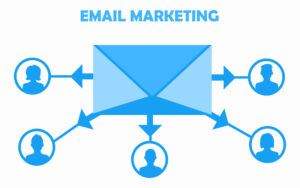
1) Industry demographics.
For example, by families, business guests, and frequent flyers.
2) Service preference:
Segment your audience according to the services clients have shown interest in before: if they used the spa or gym; if they enjoyed the pool or bar.
3) Room choice:
Segment by room choice to target the customers looking for great value and those willing to pay for quality.
The more you split up your audience, the more you will be able to provide your guests with content specific to them. The hospitality industry is all about creating individualized experiences en masse. Targeting your emails to reach a particular demographic will increase the click through rates. But sending your customers something just for them could sweeten the deal and boost bookings.
Studies suggest campaigns with personalized email subject lines are 26% more likely to get opened. And it costs nothing to place personalized content into your emails with a little know-how. Personalized emails include any information that is specific to an individual subscriber.
You choose where to put conditional fields which are then filled in with the information on your mailing list. Each email is then slightly different from the next. You often see personalization used in subject lines.
Hi <NAME>, We’ve Got Something For You is an often-used example.
Email your customers on their birthdays to wish them well. If you haven’t seen them in a while, tell them how long it has been since their last stay and ask whether they’d like to come back; send campaigns that include important updates about their particular account, loyalty program updates and special events, so they are guaranteed to get opened.
Email marketing is great not only to increase bookings, but as a method of upselling. Keeping your hotel guests posted with promotional emails about their loyalty program points, local events and room upgrades can increase revenue while making the guests’ stay even more pleasurable.
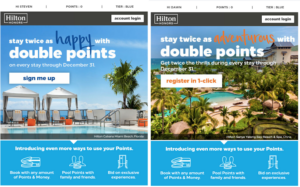
This Hilton Honors member email campaign is the perfect example of how segmenting your hotel email marketing campaign can create a more targeted connection.
Both emails have the same goal: to inform subscribers about the honors member account and its benefits. But each is tailored to a different segment of the audience. The email on the left can be sent to customers who visit to relax.
They have used the pool before; perhaps they have stayed at that particular hotel location (in the featured image). The right-hand email is for those who have displayed an interest in another specific hotel/location or who like to stay active on their trips.
The result? An email campaign that is suited to its customers’ needs, so they are more likely to open and click through to the membership account on offer.
Watch the “lead temperature”
To maximize the efficiency of your hotel email marketing campaign, you need to ensure that you send the right emails at the right time, so when you’re working on your email campaigns, don’t forget to consider the “temperature” of each lead on your email list. As a rule, guests and website visitors who have recently expressed more engagement with your content will be more responsive to promotional offers and discounts.
On the other hand, a cold lead will need to be warmed up first, as they are unlikely to make a purchase out of the blue when they receive a promotional email. But an informational email that piques their interest can be a good middle ground to make them more active.
Therefore, take care to segment your email list based on lead temperature if you want your email marketing campaign to be efficient. You can do this by segmenting your list into various categories depending on aspects such as recent travel activity, web surfing habits, and response rates to earlier email campaigns.
Segmentation done properly in this way is sure to improve your results.
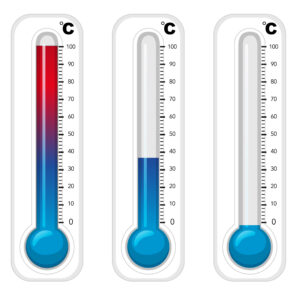
What kind of emails should you send to hot leads?
You can feel free to send promotional incentives and special offers, including savings on future reservations or accommodation category upgrades. And make sure to send follow up emails to guests who have recently stayed at your hotel, as guests after a recent positive experience will likely be open to more communication.
How to warm up cold leads?
You will need to have a more focused strategy to re-engage cooler leads. One way you can do this is by sending them tailored emails that promote particular features or activities that they would find interesting, considering their habits, web surfing patterns and past reservations (if any). Any information you have on your audience should be taken into account when trying to warm up cold leads. You can also increase cold leads’ engagement by providing incentives like loyalty program points and cost-free lodging upgrades.
3. Send Quality Content
The average person spends 11 seconds reading the average email. If you’re sending email after email and not getting the results you want, you may not be adding enough value with your content.
Upping the quality could be the boost your hotel marketing strategy needs. Sending high-quality content means making a commitment to curating and creating relevant, detailed, clear, informative, entertaining, and accessible output, to generate engagement with your brand.
What content can you give your email subscribers on their pain points to improve guest experience?
Let’s take a look at a couple of examples.
Business guests ask where the best restaurants in your area are?
Send an eye-catching newsletter exploring the ‘top ten restaurants‘ in your location.
Families struggle to find your baby changing facilities?
Create a stunning infographic map for parents to carry with them when they visit.
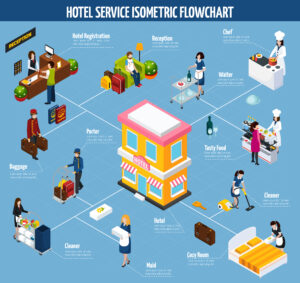
Be the best and most authoritative resource for everything your guests need to know about your location, business, and industry.
The words in your emails and web copy have a huge influence on how your brand is perceived. Your words can make your hotel friendly and personable or authoritative and high-class.
You can learn all about writing a winning email marketing copy here.
Case Study: Heritage Hotels
(Source: MailCharts)
Heritage Hotels have got their email marketing down. Above is the perfect opener for a newsletter that grabs attention and hints at the insider information that follows.
Heritage are aware of the most valuable features of their guest experience. But instead of just emailing the info to their subscribers and past hotel guests, they turn their best bits into a passionate story about the uniqueness of their location and team.
Here, we see the power of words to create an emotion. Loaded terms such as majestic, idyllic, and foothills, are used to rebrand the location as a magical place to explore.
This content is demonstrative of quality because it has a high level of detail and information while still being clear, enjoyable, and easy-to-read. It consistently sticks with the same style, tone, and voice. The reader is taken on an imaginative journey; by the time they finish, they are already picturing themselves as future guests.
Use quality content in your email campaigns to strengthen your relationship with your customers and build an authoritative brand identity, and they will always trust you to take care of their stay.
4. Ask For Feedback

Travelers are up to four times more likely to select a hotel with better online reviews; 53% of people would not book a hotel without checking reviews first. If you are not working hard to prompt customers for positive feedback, the majority of reviews will be from the minority of customers unhappy enough to complain. This is not great for business.
In addition, guest feedback will help you better understand their customer journey, which is a critical element for successful email marketing. Post stay emails are great for this: send clear and honest, targeted “thank you” emails.
Prompt your guests to share thoughts about their visit while they are still feeling the effects of their trip. You might have an idea to make a conditional offer, some reward in exchange for their feedback to increase the chances of getting a review.
Regarding conditional offers:
Your primary demographic is eloquent and intelligent; they read between the lines. Conditional offers can scare valued guests away and devalue your brand. Your customers are already primed with positivity by their stay. Sales ploys can make them suspicious, lowering the chances they will do you a favor by writing a spectacular review.
Conditional offers also mean that customers are only incentivized to provide a bare minimum of information to receive what you are offering them in return. And the feedback they provide is important. It will not only be seen by other customers. It can also help you iron out the problem areas of your business to streamline as you move into the future. Be straight with your guests and ask for honest feedback, since only reliable data yields actionable results.
A simple and heartfelt “thank you” note inviting past guests to share their experience shows your appreciation plenty. Keep it minimal and make your call-to-action the first thing your viewers see when they swipe open (keep it above the fold). They should be happy to reciprocate the appreciation after a great stay in your hotel.
Case Study: The Hansar Bangkok
(Source: Hansar Hotels)
The Hansar Bangkok offers secret rates on future bookings in their “thank you” emails. With no conditions, the offer shows their customers they care about strengthening guests, allegiance to their brand in an honest and upfront manner.
These simple, but elegantly designed emails help the Hansar manage their reputation, collect customer data, increase customer engagement and keep guests coming back for more. Send clear, well-written, and honest appreciation emails. Thank your guests in a friendly, caring, and respectable manner, and they will likely return the gratitude.
5. Create Seasonal Campaigns
Compared to hotel SEO, email marketing can be very flexible and adjust quickly to seasonal changes. Sales always increase when we get to the festive season. Wine, chocolates, and flowers produce such predictable seasonal revenue boosts because anyone would be happy to receive them. Hotel gift cards are one of these golden gifts. Most people would be happy to receive a stay in your hotel and use of its facilities.
Gift cards are flexible.
Business guests can save on their spending and couples and families can take a break. The cardholder can also redeem them whenever they like (before they expire). They are perfect if someone wants to royally treat the hard-to-buy-for. Promoting your gift cards during the festive period is a great seasonal email marketing strategy.
Provide your subscribers with a convenient gift for that special someone. Receivers have such a high incentive to spend them that every gift card you sell is likely to get more subscribers on your mailing list and more guests in for the next quarter.

Don’t forget about segmentation
Send targeted messages to different segments of your customer base. The hotel features you focus on should be particular to each segment.
If they are loyal customers, give them great content about local attractions and upcoming events they will love; if they have only stayed once give them promotional content about little-known features of your location and facilities.
Remember, the more accurately you target, the better the return.
Case Study: Jurys Inn
(Source: Jurys Inn Group)
The gift voucher campaign run by the Jurys Inn Group is efficient and direct: a short message is all it takes to tell email subscribers about the voucher and how it can be spent. It highlights the services most likely to resonate with shoppers; the use of bold, colored font makes these keywords stand out so this the most important info can be gleaned at a glance.
These emails are short, sweet, and put a great gift right in front of their subscribers with all the reasons there could be to buy. The average American spends around $1,000 on gifts, every Christmas. Make the most of it.
Create a robust email marketing campaign that will set you up for seasonal success.
6. Use analytics as much as possible
Tried-and-tested techniques can improve your results out-of-the-box. But they will also prime your email marketing system for continued growth. In today’s hospitality industry, knowing the ins and out of the customer journey is key to maximizing email marketing success.
Examples of valuable data that should be gathered:
- How many bookings were generated after a campaign
- The average open rate for the campaign
- Conversion rates of each email in the drip campaign
This data will help you set up your marketing automation in a way that ensures your future success. Another bit of advice would be to make sure that whichever email marketing tool you use has all the necessary integrations and customizations for carrying out hotel email marketing campaigns. Stay clear of options that are designed for mass mailing.
Sitewide analytics (Google, Matomo)

Welcome emails have the highest open rates, as most guests expect to receive pre arrival emails after booking. These confirmation emails can help you greatly in seeing what call-to-action phrases work best for upselling, and give you insights into the customer journey if you have tracking set up.
Be cautious though, as Google analytics may not be compliant by default with your area’s regulations, such as the GDPR. Talking about analytics: they are a great tool in general to install on your hotel website.
By setting up all the necessary tracking on the landing pages, you will get insights into the customer journey and improving the conversion rate that you would’ve never received otherwise.
7. Integrate email campaigns with social media to grow engagement
In addition to the previous points, email marketing can be used to increase the reach of all your marketing efforts.
How exactly can you use email to boost social media engagement?
The following are some methods you can employ to include social media in your email marketing campaigns:
Adding social media links and icons to email body and signature
Include clickable icons and links to your social media accounts in your emails to make it simple for your email subscribers to find and follow your hotel on social media. You can add these links and icons in many places of the email body, and you can also customize your email signature with these icons, adding a professional and polished look.
![]()
Campaign cross-promotion
You already have various social media channels – so use them to share information about your email campaigns and get more subscribers. A good way to do this is to share a link to your newsletter signup page on your social media accounts, and make a caption explaining the benefits of signing up. These benefits can range from special content to deals and discounts, at your own discretion. As long as people are signing up, everything is a good strategy.
Sharing UGC (user-generated content) on social media
When you’re sending out your email campaigns to past visitors, you can encourage them to share their experience with you. Then you can post that experience on social media, growing your brand’s reputation and increasing engagement within the community. You can even go further, and incentivize people to leave reviews by rewarding featured reviews with some special deals and promotions.
Letting people know about special email offerings on social media
Your social media subscribers should be aware of the benefits that come with a newsletter subscription to your hotel. In today’s world, when everyone is trying to clean out their inbox every day, you need to give people a really good reason to subscribe. Whatever that reason may be, make sure to share this on your social media channels.
Email Marketing For Hotels (Try DirectIQ)
(Source: DirectIQ)
DirectIQ can do all this for you.
Why pick DirectIQ when there’s already well-known, established email marketing software on the market? Most of these tools really fall short in terms of personalization for niches like hotel email marketing.
For instance, MailChimp has troubles integrating with a property management system, and generally doesn’t offer many customization options. While easy to set up, the quality of your segmentation and campaign data would suffer.
Use delivery reports and analytics to explore the devices your emails are getting read on, how many subscribers click through to your site, their geographic distribution, and more.
Add DirectIQ to your marketing arsenal and use it at full power for more engaged subscribers, more paying guests, and higher returns.
Get your email marketing in order to see the engagement and growth your hotel business deserves.







